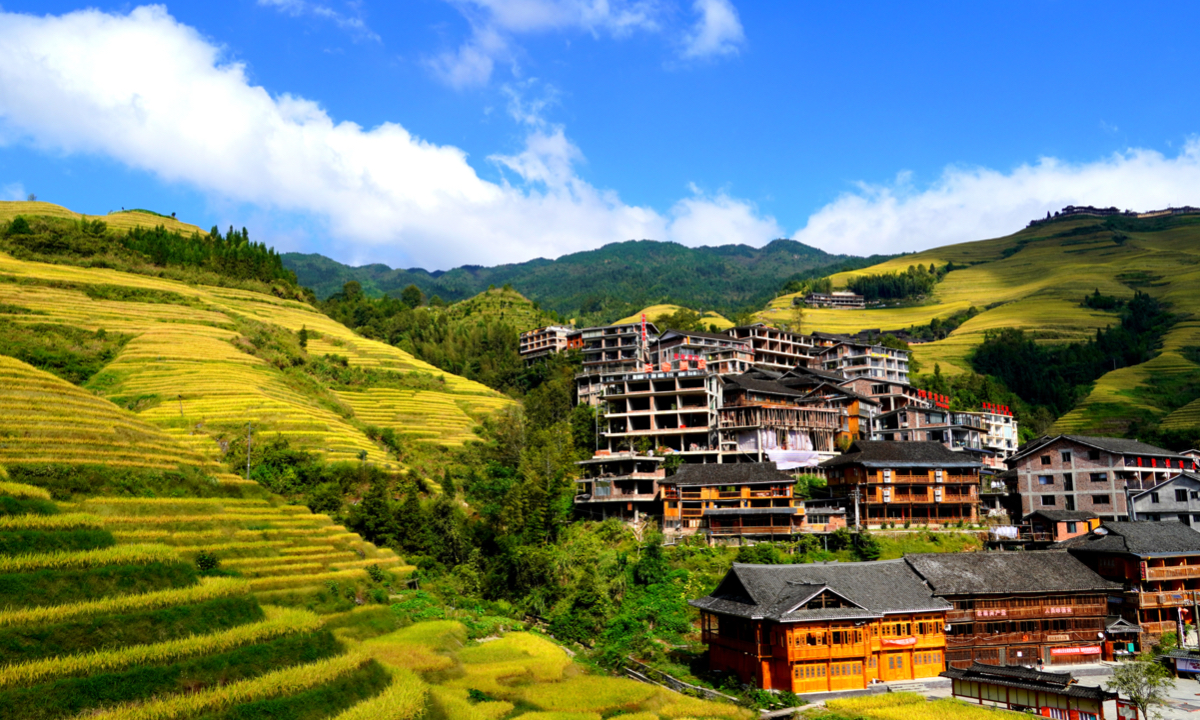
Dazhai village in Guangxi Zhuang Autonomous Region File photo: VCG

Red Yao people living in Dazhai village File photo: IC
Editor's Note:Two Chinese villages, alongside 30 other villages from around the world, have been named as Best Tourism Villages 2022 by the World Tourism Organization (UNWTO). Based on a set of criteria covering nine areas, the new Best Tourism Villages 2022, including Dazhai in South China's Guangxi Zhuang Autonomous Region and Jingzhu in Chongqing Municipality, were chosen for their ability to preserve and promote rural and community-based values, products and lifestyle and their clear commitment to innovation and sustainability in the economic, social and environmental aspects.
Over the following two editions, the Global Times will take readers on a tour of the two villages to better understand their charm, innovative efforts and local culture.
Dazhai village in the Guangxi Zhuang Autonomous Region is known as "the hometown of the world's terraced fields" as the ancient residents in the village built vast terraced fields to grow rice around 2,300 years ago. The village is part of China's famous UNESCO World Heritage Site, the Longsheng Rice Terraces.
From the village, visitors can see layers upon layers of terraces extending from the foot of the mountain upon which the village sits to its top, like a ladder to the sky.
One of the most representative terraced fields is the Golden Buddha Summit, so named because the terraces look like the Buddha when seen from the village on the opposite hill, especially when ripened rice plants cover the mountain during the fall.
Apart from this, visitors can also see the wood stilt houses in which residents live at the foot of the mountain.
Home to the Red Yao, a branch of the Yao ethnic minority group, the village still maintains a pure and simple atmosphere. The name Red Yao stems from the local custom that sees women wear clothing dyed in bright red, which symbolizes good fortune and happiness. Well-made clothing, silver ornaments and intricate head ornaments are representatives of the Red Yao's Torch Festival, also called the Clothes Drying Festival, which is an important festival for locals next to the Chinese New Year. The festival falls on the 6th day of the 6th lunar month. During the festival, every household will take out their red clothes and hang them outside the window or in the yard on a clothesline.
Dazhai village has made full use of the local farming terraces, traditional Red Yao culture and the natural scenery to develop rural tourism. Income from tourism is used to protect the ancient architecture and the beauty of the terraced fields.
The profound Red Yao culture and the magnificent terraced fields demonstrate the Chinese people's wisdom in adapting to local conditions and the unity of man and nature.
Advancing toward sustainabilityFor many rural management insiders, pristine natural scenery, especially in China's mountainous areas, is a vital part of the country's rural development strategy.
"First of all, these villages adopted measures based on their local conditions to develop tourism. Their contribution to the development of China's tourism toward an environmentally friendly direction cannot be ignored," Lü Dewen, a research fellow of rural administration studies at Wuhan University, told the Global Times on Wednesday.
Lü also noted that tourism development can also guarantee an income for local villagers.
"When developing a tourism-oriented village, local governments, tourism companies and local residents will sign a contract to ensure the fair distribution of tourism income as well as set rewards for ecological protection."
According to China's Ministry of Culture and Tourism, the local government of Dazhai village has made full use of the world-class landscape that are the terraces and carried out in-depth development of tourism, realizing the harmonious integration of agriculture and tourism, and the simultaneous prosperity of groups and individuals.
The villagers of Dazhai are responsible for cultivating their own terraced fields and repairing and strengthening the terrace walls on a regular basis, according to local news agency Guangxi News. The villagers are also rewarded with an average of nearly 6,000 yuan ($860) per mu (666 square meters) every year to provide them income and to protect this heritage at the same time.
In addition to the bonus, "there are also national subsidies for us as farmers, and income from homestays, all of which form a cycle of ecological protection and economic development," said local villager Yu Qiongtong.
The farmer and hotel runner spent two years building a spectacular traditional compound for his homestay business.
"Having the village gain global attention [through UNWTO] shows an appreciation for China's ecological protection efforts as well as recognition of this model's commercial value," added Lü.
Previously, the Yucun village in East China's Zhejiang Province and Xidi village in East China's Anhui Province were recognized as Best Tourism Villages by the UNWTO, which launched the initiative in 2021, the Xinhua News Agency reported.





